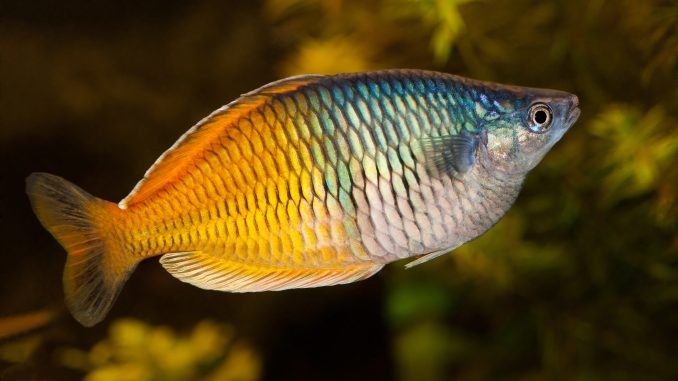
Colorful fish get a lot of attention in the aquarium industry. We are naturally drawn to vibrant species with interesting designs. This is why Rainbowfish are so popular when there are so many species to choose from.
Boesemani Rainbowfish is an excellent example. They possess a simple yet attractive design that is filled with color. This has made them a common sight in home aquariums.
Their ease of care makes them even more desirable. Their preferences are simple to cater to so even beginners can look after a shoal without running into problems.
With a little research, anyone can start an aquarium for Boesemani Rainbowfish. We are here to tell you everything you might need to know when keeping them for the first time.
TABLE OF CONTENTS
Boesemani Rainbowfish Facts & Overview
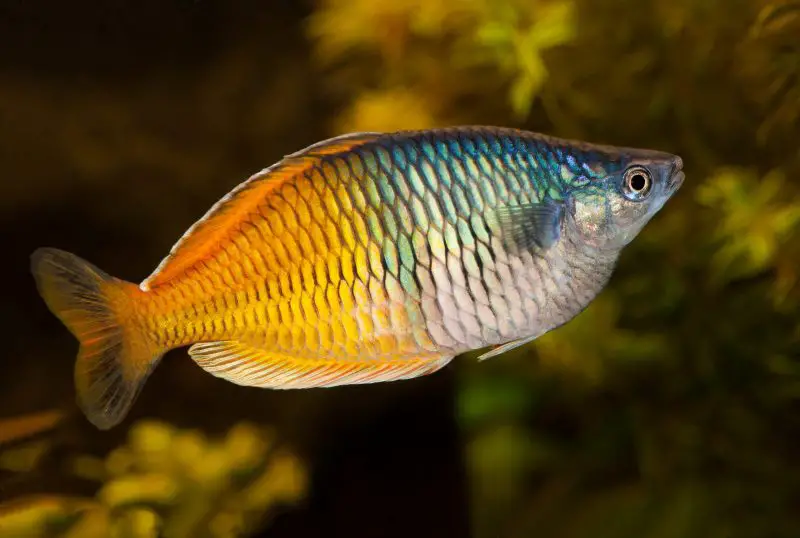
| Category | Rating |
| Care Level: | Easy |
| Temperament: | Peaceful |
| Color Form: | Blue heads with red rears |
| Lifespan: | 5-8 years |
| Size: | Up to 4.5 inches |
| Diet: | Omnivore |
| Family: | Melanotaeniidae |
| Minimum Tank Size: | 30 gallons |
| Tank Set-Up: | Freshwater with plants and swimming spaces |
| Compatibility: | Peaceful community |
Boesemani Rainbowfish (Melanotaenia boesemani) is a popular freshwater species. Also known as Boeseman’s Rainbowfish, they belong to the Melanotaeniidae family.
This family contains many different species of Rainbowfish, a group named for their bright colors. Boesemani Rainbowfish is no exception, boasting lots of colors to brighten your aquarium.
They enjoy a tropical climate and spend most of their time in the shallows of the Ayamaru Lakes in Indonesia, to which they are endemic. This means that these lakes are the only places that natural populations of Boesemani Rainbowfish can be found.
However, this species is extensively bred in captivity and can be found in most pet shops. Price can vary a little, but you’ll probably be paying between $5 and $10 per fish.
Boesemani Rainbowfish can live for quite a long time, usually 5-8 years. This is dependent on them being kept in a healthy tank that matches all their preferences. Some individuals may even reach the age of 12 years old!
If you’ve read up on their care needs, these fish are easy to care for. This makes them ideal for beginners who are looking for an attractive species that aren’t very demanding.
Typical Behavior
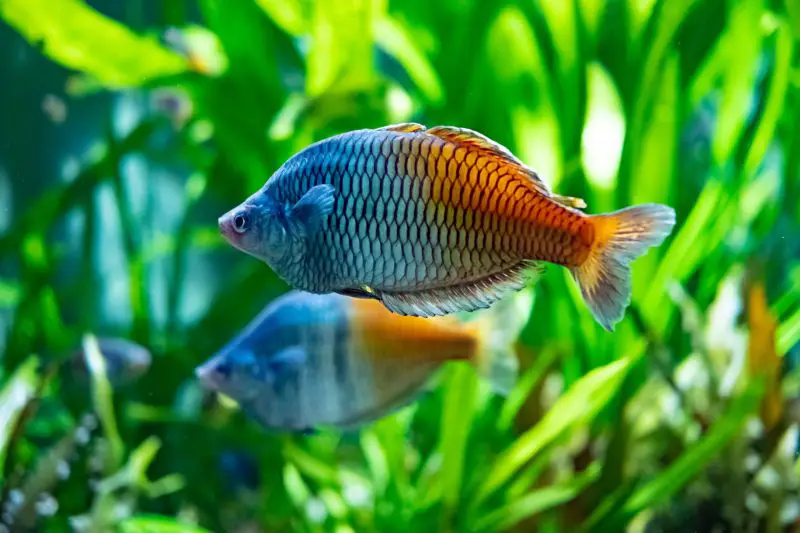
These fish are excellent choices for a community aquarium because of their peaceful nature. They can’t be kept with all fish though, so you will need to identify some suitable tank mates.
Sometimes Boesemani Rainbowfish will move rapidly which can stress slow-moving/skittish fish, especially since they are fairly large.
They occupy the middle levels of the water column where they tend to be quite active if kept healthy. They constantly move around open swimming spaces, displaying their colors.
They are a social species too, mixing well with both other species and their own kind. As shoaling fish, they should be kept in groups to keep them happy.
A shoal really exaggerates their colors and behaviors as they move in unison.
Appearance
There is a reason they have been given the name “Rainbowfish”. This bright species will grab your attention with their colorful displays.
Boesemani Rainbowfish is essentially a species of two halves. Their rear is composed of warm colors like reds, oranges, or yellows. Their head is the opposite, displaying cooler blues, greens, or purples.
Though they cannot change their colors, each fish can control its intensity. This usually reflects mood or health. Intense colors might indicate that the fish is ready to mate, but pale colors might signal illness or stress.
The environment and social interactions can also influence how they change their color.
Their body is shaped like a flat oval, with their tail fin poking out at the end. The rest of their fins are relatively small and don’t extend far from the body.
The dorsal and anal fins, on the top and bottom of their body respectively, run along the rear half of their body and stop and the tail fin.
Their head narrows to a point at the front. They have small mouths and large eyes.
You can determine the sex of this species by looking at their size and color. Males are usually larger, brighter, and have a deeper body than females.
A fully grown male can reach 4.5 inches long, but females don’t grow much larger than 3 inches.
Habitat and Tank Conditions
Populations of Boesemani Rainbowfish are very localized to a specific area. They can only be found naturally in the Ayamaru Lakes of Indonesia.
The warm climate is perfect for these tropical fish. They keep to the shallow waters, away from larger predators that can be found in the deeper regions.
These shallow areas are densely planted with vegetation that offers a certain amount of security.
The floor of the lake would be covered in sands, rocks, and debris though is of little importance to this species as they stay higher up.
The slow-moving water would be hard, alkaline, and well-lit.
Boesemani Rainbowfish are endemic to these lakes because the conditions are perfect. If you want your fish to stay healthy in captivity, you must recreate their natural environment.
Tank Conditions
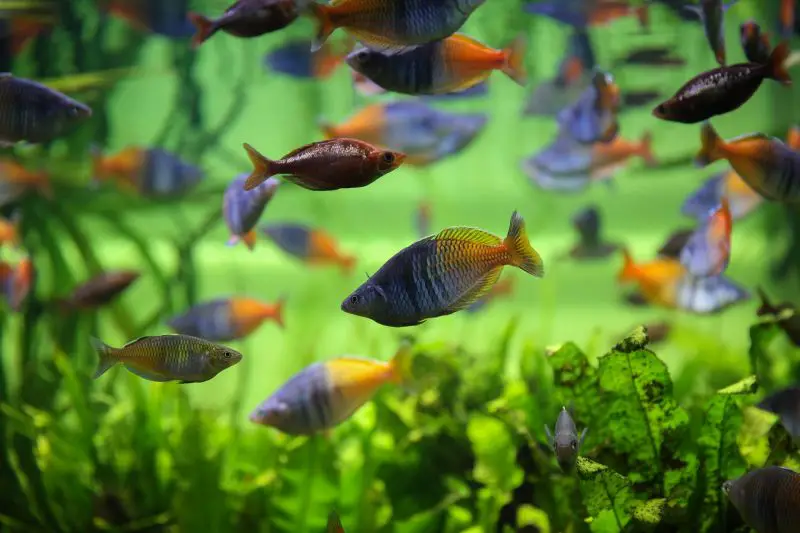
When designing the interior of an aquarium, it makes sense to start at the bottom. Boesemani Rainbowfish don’t spend much time here, so you could choose a substrate based on the preferences of their tank mates.
Sand is usually a safe choice because the fine grains are unlikely to scratch if a fish ventures downwards, perhaps in search of food.
You can choose some decorations to sit on top of the substrate, but the most important things are live plants. Ensure that you have some densely planted areas for your fish to retreat to.
Do not fill the tank too much with plants and decorations though, open swimming spaces are important too.
The only pieces of equipment you’ll need are a filter and a heater. Air and water pumps are unnecessary due to these fish prefer slow-moving water. Standard aquarium lighting should be fine too.
Set your heater to 81-86°F and keep the water’s pH between 7.0 and 8.0.
What Size Aquarium do they need?
A group of six can be held in a 30-gallon aquarium. Any smaller than this and they would become cramped and stressed.
As an active species, Boesemani Rainbowfish need plenty of space to swim around in, so the larger the tank, the better.
How Many Can be kept per gallon?
As your shoal increases in size, your tank will have to as well. Each additional fish will need an extra 5 gallons in the aquarium.
Tank Mates
Since their geographical range is so narrow, the number of species they’d naturally encounter is low.
You’re not limited to species from the Ayamaru Lakes though, you can pick any suitable tank mates from around the world.
Boesemani Rainbowfish are very peaceful, so you don’t need to worry about them starting fights and injuring your other fish.
They can scare slow-moving or skittish fish though because they are larger and sometimes move rapidly. Factor this into your choice of tank mates.
Sometimes Boesemani Rainbowfish can be skittish themselves, but they’re much more confident when part of a shoal.
Ideal tank mates would be of a similar size or smaller. You could try Danios (e.g. Zebras or Pearls), Tiger Barbs, Corydoras Catfish, large Tetras, Rasboras, or even other Rainbowfish.
Some Rift Lake Cichlids can be suitable too, due to their similar water preferences.
Their peaceful nature, and small mouths, mean that you can choose invertebrates as tank mates too. Assassin Snails or Ghost Shrimp can make excellent additions by offering a completely different aesthetic.
Boesemani Rainbowfish are very well matched to a peaceful community aquarium.
Can You Keep Boesemani Rainbowfish Together?
Yes, you can keep them together, and you should. This species naturally shoals with others of its own kind. A group in captivity should be composed of at least 6-8 members. The larger the group, the happier they will be.
A single individual would become very stressed on its own, which would lead to a loss of color and health problems.
Diet
Boesemani Rainbowfish are omnivores; they eat both meaty food and vegetation. They’ll eat whatever they come across. The only thing that limits their diets is their small mouths.
In the wild, they would eat small pieces of plant matter or tiny insect larvae. These foods are very easy to supply at home.
Dried, prepared foods (such as flakes and pellets) are always an option. These are very convenient and contain lots of ingredients to provide a range of nutrients.
However, many of the nutrients are lost in the manufacturing process, so dried foods should be supplemented with frozen/live foods. These are full of nutrients and are great for bringing out the color of your fish, which is particularly rewarding with Rainbowfish.
Mosquito larvae and daphnia are a couple of great examples.
Boesemani Rainbowfish will eat green vegetables, so you could cut up small pieces of spinach or zucchini to add to the tank. You could make some homemade fish foods too.
Though they eat vegetation, they should leave most of your live plants untouched, limiting themselves to plant debris that breaks away.
Only give them an amount of food that they can finish in a couple of minutes to prevent overfeeding. Doing this twice a day should ensure that their digestive system isn’t overworked.
Care
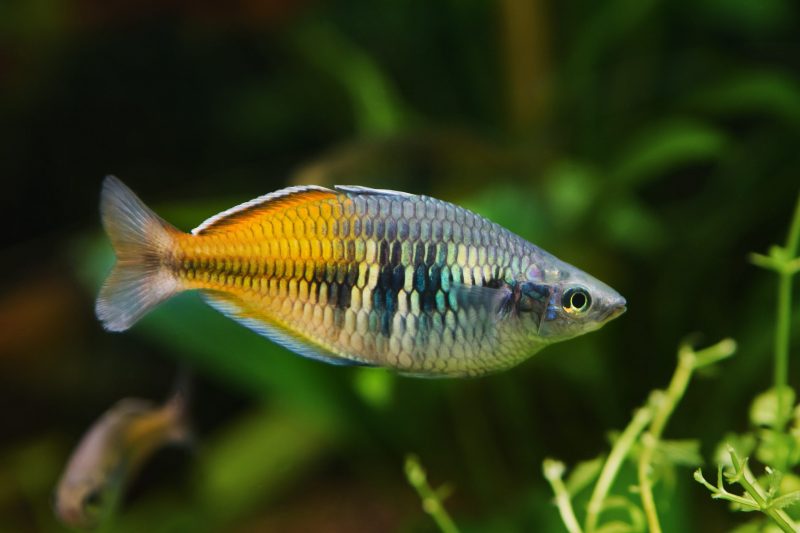
Caring for these fish is a delight because they keep to themselves and don’t need much attention from you. Their needs are undemanding which is why they are great for beginner aquarists.
Like with all fish, a clean tank is paramount to their survival. Simple jobs like partial water changes and wiping away excess algae will help this species to live out their full lifespan.
Use a water testing kit to check the parameters of the water each week. If a problem occurs, you can then catch it early before it can harm your fish.
Diseases are rarely a problem if the tank is clean and you’re feeding your fish a healthy diet. Poor water conditions allow pathogens to thrive, and fish need plenty of nutrients to fight them off.
Sometimes pathogens from a pet shop are introduced to your aquarium when you add some new fish, so always quarantine them first. The same should be done for secondhand equipment.
A common disease that every keeper should be aware of is Ich, also known as white spot disease. This ectoparasite produces white spots across the affected fish’s body. They may lose their appetite and/or develop cloudy eyes too.
If you notice that a fish has picked up a disease, quarantine them immediately for treatment. There are commercial medicines available for most diseases.
Changing Colors
If your Boesemani Rainbow fish change colors it could mean one of many things.
If their colors fade, it is usually a signal that something is wrong. It could just mean that the fish is stressed, perhaps they have been chased by a tank mate. In this instance, their colors would soon return to normal.
A longer-term loss of color could mean that there is something wrong in their environment. Use a water testing kit to check that all of the water parameters are within their preferred range.
Check the fish for signs of disease too, as a loss of color is a symptom of many common freshwater diseases.
If the aquarium seems fine and they don’t appear to be ill, the problem could be their diet.
A nutritious diet is crucial for maintaining the bright colors of your Boesemani Rainbowfish. Carotenoids are particularly important for the colored pigments of your fish.
A diet formed solely of dried foods is often the problem. Many of the nutrients are lost during manufacturing, so try mixing in some live/frozen foods instead.
You may notice that the colors on your fish are getting brighter, rather than paler. This often happens when as they begin getting comfortable in their new environment.
It could mean that they are getting ready to mate as well.
Breeding
Boesemani Rainbowfish aren’t too difficult to breed at home, the hardest part is raising the fry.
Perfect conditions are crucial for successful reproduction. Ideally, the pH would be 7.5 and the temperature would be around 82°F. A healthy diet is very important too.
If your fish don’t seem to be spawning, try raising the temperature slightly, as this is a natural trigger.
You can tell when these egg-scatterers are ready to mate. Females will appear plump and males will start displaying to each other.
A male will find a female and show off the mating stripe on his forehead. He will then fertilize her eggs as they move over planted areas.
A pair will spawn for a few weeks, laying newly fertilized eggs each day.
After 7-12 days, the eggs will hatch. Make sure they are separated from anything that might eat them. The parents rarely eat their young.
Initially, feed the fry infusoria. After a week you can move onto something a little larger like brine shrimp nauplii until they are large enough to eat an adult’s diet.
The fry will likely stay near the surface of the water so you can’t use sinking foods.
Are Boesemani Rainbowfish Suitable for Your Aquarium?
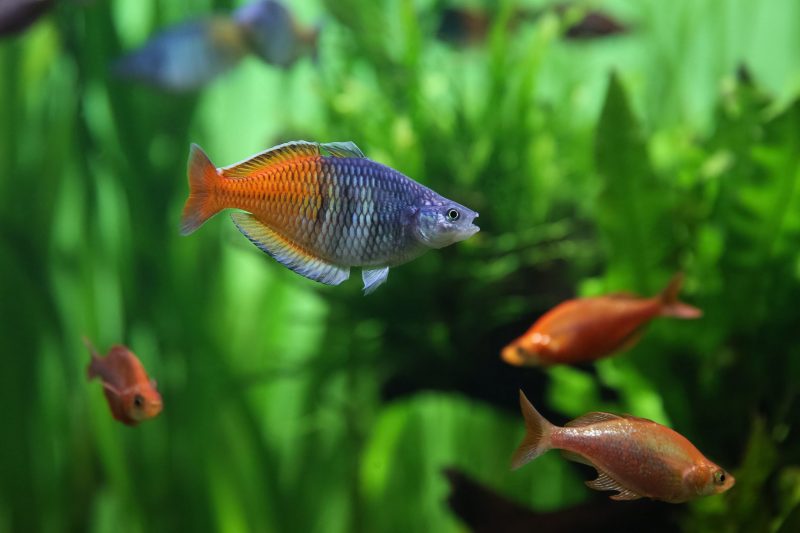
Anyone will be able to care for these fish if they have read up about their preferences. This article should have filled you in on all the important information.
It is easy to design the perfect aquarium because the conditions of their natural habitat are simple to replicate. Many other species enjoy similar water conditions, so picking tank mates is easy too.
Beginners will find that Boesemani Rainbowfish make a great starting point for the fishkeeping hobby. The beauty of this species keeps experienced aquarists enthralled too.
It is difficult to find a reason not to get some; a shoal of Boesemani Rainbowfish will keep everyone happy.

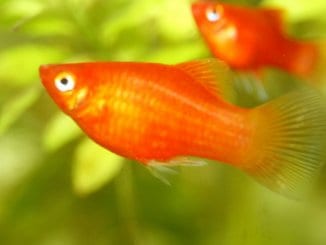
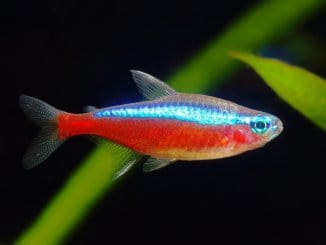
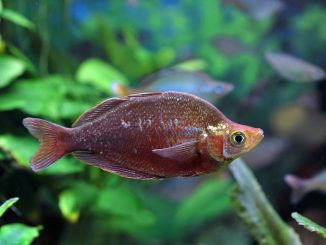
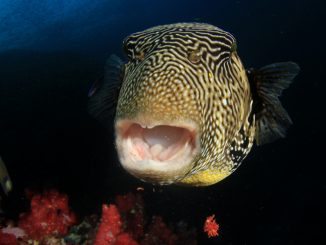
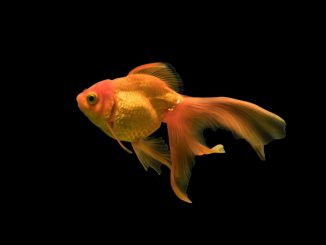
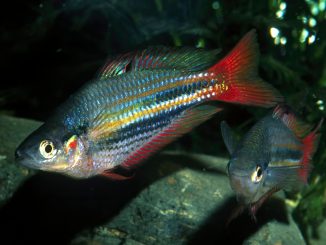
Boesemani Raimbows are really great fish. The only problem I have is sometime they show a type of cotton like fungus around there mouths and the other day I noticed the same on the side of one. I’m wondering how to treat this problem.
SAME! I have a few different Rainbow fish, and Boesemani. Same problem I have. The white around the mouths seems to come and go. Sometimes I take them out and quarantine them in a salt bath with some meds, it does help when it gets bad. It comes and goes. Water parameters are perfect and I do weekly water changes. From what I researched their mouths tend to developed that when stressed or when the bump into rough stuff in the tank. How are your Rainbows doing? I’ve tried to talk to the Local fish store I got them from but they told me not to worry if it goes away.
Has anyone ever seen a short bodied male bosmani rainbow fish. I bought one.
Thank’s for the information, I lern a lot about boesemani.